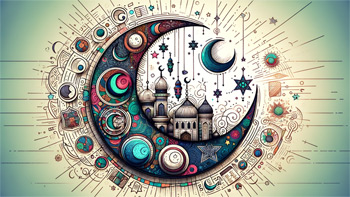The Islamic calendar, also known as the Hijri or lunar calendar, is a vital component of the Muslim faith, guiding the observance of religious ceremonies and festivals. Unlike the Gregorian calendar, which is solar-based, the Islamic calendar is based on the lunar cycle, comprising 354 or 355 days in a year. This difference in the foundational structure leads to the Islamic months moving through the seasons over time, offering a unique rhythm to the spiritual and communal life of Muslims worldwide.
Origins of the Islamic Calendar
The Islamic calendar was established during the time of Prophet Muhammad to unify the Muslim community over religious dates and practices. It starts from the Hijra, the migration of Prophet Muhammad from Mecca to Medina, which occurred in 622 CE. This pivotal event not only marked the beginning of the Islamic community but also the start of the Islamic lunar calendar. The Hijri calendar’s purpose was to streamline the timing of religious observances, such as Ramadan, Hajj, and other significant Islamic events, across the expanding Muslim world.
Structure of the Islamic Calendar
The Islamic calendar consists of 12 months, similar to the Gregorian calendar, but each month is either 29 or 30 days long, depending on the sighting of the moon. The months are: Muharram, Safar, Rabi' al-awwal, Rabi' al-thani, Jumada al-awwal, Jumada al-thani, Rajab, Sha'ban, Ramadan, Shawwal, Dhu al-Qi'dah, and Dhu al-Hijjah. Among these, Ramadan, the month of fasting, and Dhu al-Hijjah, the month of the Hajj pilgrimage, hold significant religious importance.
Significance of Lunar Observation
One of the unique aspects of the Islamic calendar is its reliance on lunar observation to mark the beginning and end of months. This practice means that the Islamic calendar remains closely connected to the natural world, with the physical sighting of the moon playing a crucial role in determining the start of each month. This reliance on lunar sighting has also led to variations in the observance of Islamic dates across different communities, depending on local visibility conditions.
Impact on Islamic Festivals and Holidays
The Islamic calendar dictates the timing of all Islamic holidays and festivals. The most well-known of these are Eid al-Fitr, which marks the end of Ramadan, and Eid al-Adha, which coincides with the Hajj pilgrimage and commemorates Prophet Abraham’s willingness to sacrifice his son in obedience to God. Since the Islamic calendar is shorter than the solar year by about 10 to 12 days, Islamic festivals move through the seasons, offering a dynamic spiritual rhythm to the lives of Muslims.
Islamic Calendar in Contemporary Times
In modern times, the Islamic calendar continues to serve as a cornerstone of religious and cultural identity for Muslims. It not only governs the timing of religious observances but also influences everyday life, including legal matters, education, and cultural events in many Muslim-majority countries. Advances in astronomy have allowed for more precise predictions of the lunar cycle, enabling better planning of Islamic events and festivals. However, the traditional practice of moon sighting remains a cherished aspect of Islamic tradition, symbolizing a direct link to the natural world and the divine.
The Islamic calendar embodies more than a method of marking time; it represents a continuous link to the past and a guide for daily living in the present. Through its months and observances, the Hijri calendar offers a unique lens through which Muslims around the world view their history, spirituality, and community. As the Islamic calendar continues to mark the rhythm of religious life, it stands as a testament to the enduring legacy and unity of the Muslim faith, weaving together the diverse tapestry of Islamic cultures across the globe.
